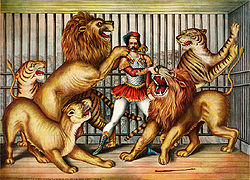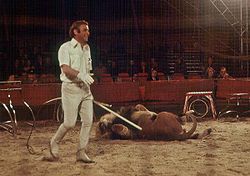 19th-century lithograph of a lion tamer | |
| Occupation | |
|---|---|
Occupation type | Performing arts |
Activity sectors | Entertainment, show business |
| Description | |
Fields of employment | Circus |
Related jobs | Animal trainer |

Lion taming is the taming and training of lions, either for protection or for use in entertainment, such as the circus. The term often applies to the taming and display of lions and other big cats such as tigers, leopards, jaguars, cheetahs, and cougars. People often use lion taming as a metaphor for any dangerous activity. Lion taming occurs in zoos around the world to enable the keepers to carry out medical procedures and feedings.
The Captive Animals Protection Society maintains that animal welfare cannot be guaranteed in circuses. [1]